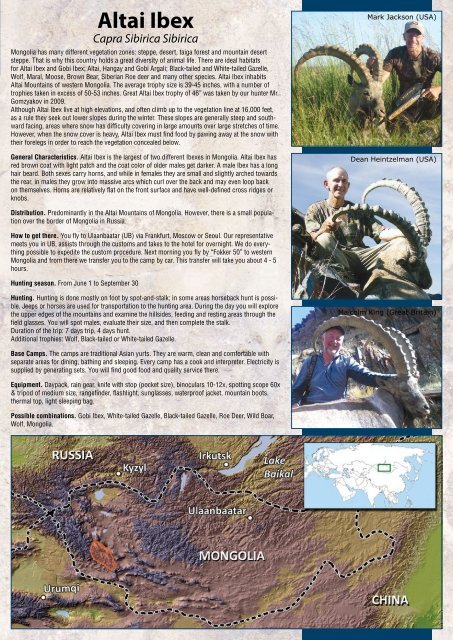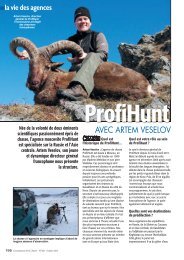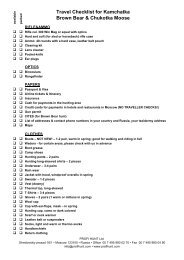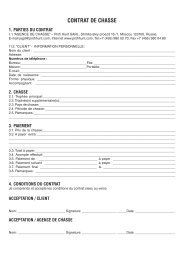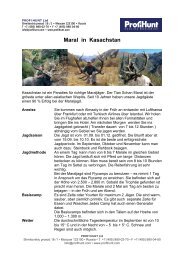Create successful ePaper yourself
Turn your PDF publications into a flip-book with our unique Google optimized e-Paper software.
Altai Ibex<br />
Capra Sibirica Sibirica<br />
Mongolia has many different vegetation zones: steppe, desert, taiga forest and mountain desert<br />
steppe. That is why this country holds a great diversity of animal life. There are ideal habitats<br />
for Altai Ibex and Gobi Ibex; Altai, Hangay and Gobi Argali; Black-tailed and White-tailed Gazelle,<br />
Wolf, Maral, Moose, Brown Bear, Siberian Roe deer and many other species. Altai Ibex inhabits<br />
Altai Mountains of western Mongolia. The average trophy size is 39-45 inches, with a number of<br />
trophies taken in excess of 50-53 inches. Great Altai Ibex trophy of 46” was taken by our hunter Mr.<br />
Gomzyakov in 2009.<br />
Although Altai Ibex live at high elevations, and often climb up to the vegetation line at 16,000 feet,<br />
as a rule they seek out lower slopes during the winter. These slopes are generally steep and southward<br />
facing, areas where snow has difficulty covering in large amounts over large stretches of time.<br />
However, when the snow cover is heavy, Altai Ibex must find food by pawing away at the snow with<br />
their forelegs in order to reach the vegetation concealed below.<br />
General Characteristics. Altai Ibex is the largest of two different Ibexes in Mongolia. Altai Ibex has<br />
red brown coat with light patch and the coat color of older males get darker. A male Ibex has a long<br />
hair beard. Both sexes carry horns, and while in females they are small and slightly arched towards<br />
the rear, in males they grow into massive arcs which curl over the back and may even loop back<br />
on themselves. Horns are relatively flat on the front surface and have well-defined cross ridges or<br />
knobs.<br />
Distribution. Predominantly in the Altai Mountains of Mongolia. However, there is a small population<br />
over the border of Mongolia in Russia.<br />
How to get there. You fly to Ulaanbaatar (UB) via Frankfurt, Moscow or Seoul. Our representative<br />
meets you in UB, assists through the customs and takes to the hotel for overnight. We do everything<br />
possible to expedite the custom procedure. Next morning you fly by “Fokker 50” to western<br />
Mongolia and from there we transfer you to the camp by car. This transfer will take you about 4 - 5<br />
hours.<br />
Hunting season. From June 1 to September 30<br />
Hunting. Hunting is done mostly on foot by spot-and-stalk; in some areas horseback hunt is possible.<br />
Jeeps or horses are used for transportation to the hunting area. During the day you will explore<br />
the upper edges of the mountains and examine the hillsides, feeding and resting areas through the<br />
field glasses. You will spot males, evaluate their size, and then complete the stalk.<br />
Duration of the trip: 7 days trip, 4 days hunt.<br />
Additional trophies: Wolf, Black-tailed or White-tailed Gazelle.<br />
Base Camps. The camps are traditional Asian yurts. They are warm, clean and comfortable with<br />
separate areas for dining, bathing and sleeping. Every camp has a cook and interpreter. Electricity is<br />
supplied by generating sets. You will find good food and quality service there.<br />
Equipment. Daypack, rain gear, knife with stop (pocket size), binoculars 10-12x, spotting scope 60x<br />
& tripod of medium size, rangefinder, flashlight, sunglasses, waterproof jacket, mountain boots,<br />
thermal top, light sleeping bag.<br />
Possible combinations. Gobi Ibex, White-tailed Gazelle, Black-tailed Gazelle, Roe Deer, Wild Boar,<br />
Wolf, Mongolia.<br />
Mark Jackson (USA)<br />
Dean Heintzelman (USA)<br />
Malcolm King (Great Britain)


